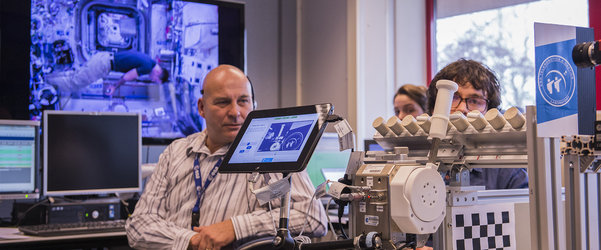Accept all cookies Accept only essential cookies See our Cookie Notice

About ESA
The European Space Agency (ESA) is Europe’s gateway to space. Its mission is to shape the development of Europe’s space capability and ensure that investment in space continues to deliver benefits to the citizens of Europe and the world.
Highlights
ESA - United space in Europe
This is ESA ESA facts Member States & Cooperating States Funding Director General Top management For Member State Delegations European vision European Space Policy ESA & EU Space Councils Responsibility & Sustainability Annual Report Calendar of meetings Corporate newsEstablishments & sites
ESA Headquarters ESA ESTEC ESA ESOC ESA ESRIN ESA EAC ESA ESAC Europe's Spaceport ESA ESEC ESA ECSAT Brussels Office Washington OfficeWorking with ESA
Business with ESA ESA Commercialisation Gateway Law at ESA Careers Cyber resilience at ESA IT at ESA Newsroom Partnerships Merchandising Licence Education Open Space Innovation Platform Integrity and Reporting Administrative Tribunal Health and SafetyMore about ESA
History ESA Historical Archives Exhibitions Publications Art & Culture ESA Merchandise Kids Diversity ESA Brand Centre ESA ChampionsLatest
Space in Member States
Find out more about space activities in our 23 Member States, and understand how ESA works together with their national agencies, institutions and organisations.
Science & Exploration
Exploring our Solar System and unlocking the secrets of the Universe
Go to topicAstronauts
Missions
Juice Euclid Webb Solar Orbiter BepiColombo Gaia ExoMars Cheops Exoplanet missions More missionsActivities
International Space Station Orion service module Gateway Concordia Caves & Pangaea BenefitsLatest
Space Safety
Protecting life and infrastructure on Earth and in orbit
Go to topicAsteroids
Asteroids and Planetary Defence Asteroid danger explained Flyeye telescope: asteroid detection Hera mission: asteroid deflection Near-Earth Object Coordination CentreSpace junk
About space debris Space debris by the numbers Space Environment Report In space refuelling, refurbishing and removingSafety from space
Clean Space ecodesign Zero Debris Technologies Space for Earth Supporting Sustainable DevelopmentLatest
Applications
Using space to benefit citizens and meet future challenges on Earth
Go to topicObserving the Earth
Observing the Earth Future EO Copernicus Meteorology Space for our climate Satellite missionsCommercialisation
ESA Commercialisation Gateway Open Space Innovation Platform Business Incubation ESA Space SolutionsLatest
Enabling & Support
Making space accessible and developing the technologies for the future
Go to topicBuilding missions
Space Engineering and Technology Test centre Laboratories Concurrent Design Facility Preparing for the future Shaping the Future Discovery and Preparation Advanced Concepts TeamSpace transportation
Space Transportation Ariane Vega Space Rider Future space transportation Boost! Europe's Spaceport Launches from Europe's Spaceport from 2012Latest

Home away from home planet
Thank you for liking
You have already liked this page, you can only like it once!
As a month of celebrating 20 years of continuous human habitation of the International Space Station draws to a close, we look back on the first mission of the next ESA astronaut to travel to the Space Station, Thomas Pesquet.
The ESA astronaut of French nationality lived and worked on the Space Station for 196 days during his first mission, Proxima, between November 2016 and June 2017. Thomas is one of 18 European astronauts to have spent time on board and will return for his Alpha mission in spring 2021.
Thomas is seen here working in the European Columbus laboratory that was launched to the Station in February 2008.
The Columbus laboratory is Europe’s largest single contribution to the International Space Station. Permanently attached to the Harmony module, this pressurised laboratory allows researchers on the ground, aided by the Station’s crew, to conduct a wide variety of research in a weightless environment.
Experiments in space science, Earth observation and technology can also be conducted outside the module, thanks to four exterior mounting platforms that are exposed to the vacuum of space. Room outside Columbus for commercial experiments is also on its way, with the Bartolomeo services due to begin operations soon.
During his upcoming Alpha mission, Thomas will continue this research and experimentation on the International Space Station supported by his crewmates and ground teams from ESA, the US space agency NASA, Russian space agency Roscosmos, the Canadian Space Agency and the Japanese space agency JAXA.
This enduring international partnership is a key feature of the Space Station as nations work across cultures and borders, performing science, research and engineering that has led to breakthroughs in disease research, materials science, Earth observation, our understanding of Earth’s origins and more.
This work helps humankind explore even farther while enhancing life here on Earth – setting Europe in good stead for its journey forward, beyond low Earth orbit to the Moon.
-
CREDIT
ESA/NASA -
LICENCE
ESA Standard Licence

Thomas feels home

Home from home

ESA ISS Mission Patches

Thomas in Columbus















 Germany
Germany
 Austria
Austria
 Belgium
Belgium
 Denmark
Denmark
 Spain
Spain
 Estonia
Estonia
 Finland
Finland
 France
France
 Greece
Greece
 Hungary
Hungary
 Ireland
Ireland
 Italy
Italy
 Luxembourg
Luxembourg
 Norway
Norway
 The Netherlands
The Netherlands
 Poland
Poland
 Portugal
Portugal
 Czechia
Czechia
 Romania
Romania
 United Kingdom
United Kingdom
 Slovenia
Slovenia
 Sweden
Sweden
 Switzerland
Switzerland

























